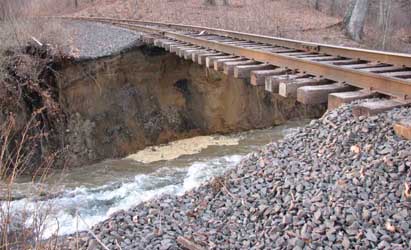Organizing to Stop The Dumps
On December 1 Tim Gray of the Housatonic River Initiative (HRI) organized a meeting of concerned citizens to discuss a GE proposal to locate PCB dumps in the southern Berkshires. The six proposed sites include the property of the Lane Construction Company’s gravel pit in Lenoxdale and Forest Street in Lee, which Tim Gray points out is very close to Upper Goose Pond and Lower Goose Pond which are pristine and which feed the new catch-and-release area of the Housatonic River. An area near Rising Pond in Housatonic was also on GE’s list.
The meeting was well attended and many viewpoints were expressed. BEAT videotaped the event. We at BEAT have been expressing our feelings and opinions about this process and about how we feel the cleanup should proceed on our blog.
Comments are closed.




Well said Jane,
I believe “SED3/FP3” must move down the river in localized stages leaving behind fully remediated, planted, and viable habitats for both wildlife and humans to enjoy. This is the only process I can imagine would take more than ten years.
GE has grossly exaggerated the scenario using the methods employed in the first two miles as an ugly example. In fact, I think GE knew to make the first stage as ugly as possible in order to have marketing material for this negotiation.
Separate issue: Does anyone know why the process is ordered in this way? GE presents a highly slick and distorted presentation designed to generate sympathy for their “Monitored Natural Recovery” option. And then the EPA sits back and waits for public comment which is unfocused because of the distortions. Then, finally the EPA will be heard from.
Can’t we see some sort of counterpoint from someone who does not have a conflict of interest before we can make comments?
Why does this whole process seem to ignore the implicit conflict of interest in this GE proposal — the CMS document/video? I think the EPA got one hand tied behind its back when Pittsfield sided with GE to avoid the “Superfund” designation back in 1997. I think the Superfund rules would have had the EPA presenting options for public opinion and GE would be forced to shut up and write the checks.
Hind-sight is 20/20 as GE is has more power to drag out the whole process as long as possible so the cost is less for each fiscal year.
Hi Dave,
We’re familiar with the video you received. It’s a really slick propaganda piece. Let me give you some context.
GE filed a report with EPA presenting their thoughts on the upcoming cleaning. In it, they suggested their preferences for how the cleanup should proceed. They are now suggesting to the public that these are the options from which we all must choose. How convenient. The people who created the mess get to suggest how they should be made to clean it up. They say that the reason they presented the report is that EPA is deciding whether “additional construction” should occur along the river. Actually, EPA is deciding how cleanup should proceed and what GE’s responsibility will be.
No surprise. GE suggests as one of the options that they should do absolutely nothing and spend almost nothing. Their spin team though decided to call this option “Monitored Natural Recovery.” The river won’t recover on its own. PCBs will stay there for generations. Also notice that the option that would cost them the most money they called “SED3/FP3”: evil brand X.
Perhaps bowing to reality and realizing that they may not get away with doing absolutely nothing, they came up with an option that involves doing almost absolutely nothing. They cleverly call it the “Ecologically Sensitive Solution.” They called it that. Nobody else did.
They also want us to believe that the only two solutions are to leave the river alone (leave GE alone) or inflict massive destruction on the riverbanks. This isn’t the case either. Everyone agrees the riprap in Pittsfield was handled badly. EPA and others learned from their mistakes. This wouldn’t have to be how the rest of the river is handled.
We’ve heard from people that they don’t want the river to be destroyed. Some people point out that the wildlife is just fine right now and that we should leave it alone. GE in their video points to a post-cleanup vernal pool that is not functioning. First of all, that vernal pool was not functioning before the cleanup, probably due to toxics, and some of that was PCBs. Low levels of PCBs in the area mean that none of our vernal pools along the river are functioning properly. Yet GE points to it and says “look at what the cleanup did.” Also, the wildlife along the river is not doing fine. Fish have deformities and ducks have levels of PCBs in their tissues that would necessitate their being disposed of as high-level toxic waste. Animals that look healthy to the casual observer are not always healthy.
We take issue with everything GE is trying to sell the public.
Before any cleanup had begun, GE took out full-page ads in the Berkshire Eagle. They told the public that PCBs remain attached to the soil, so PCBs would not be in the water or the air. Well, it turns out that was not true. PCBs do travel in the water and they do volatilize. There are studies that show just living near PCBs puts people at greater risk of all sorts of health problems.
So we believe that a serious cleanup is in order. However, we do not buy GE’s assertion that you have to destroy everything to cleanup the river and the floodplain.
A truly ecologically sensitive approach would consider each small ecosystem individually, by assessing the levels of PCBs in each area and devising a plan to remove the PCBs in the most environmentally sensitive way for that area. The goal would be to restore each section to conditions as they existed before remediation and to do this in the most ecologically beneficial way. Plans could include removing invasive, non-native species and perhaps adding special features for rare or endangered species.
BEAT is asking that EPA not lock us in to any one approach to remediating the river, but allow an “adaptive management” approach where we clean one small ecosystem and restore it. We should observe what worked well, and what could be improved upon, and learn as we go. There are many new technologies for dredging without allowing contamination to go downstream, for treating PCBs, and for monitoring results. Let’s look at each small section of the river as a unique habitat needing its own solution, and lets monitor our progress and learn from it. We should have learned our lesson from the consent decree that locking down a rigid system with signatures will only lead to regret later.
HI Jane,
I recently watched a video (mailed to me from GE) titled “The Housatonic: The fate of a river”.
Of the options they present, although I’m sure biased in favor of the company’s interests, from “leave it alone” to “total dredging”, does BEAT favor/recommend, and why. Maybe you’ve already published something on this that you can refer me to. Thanks!